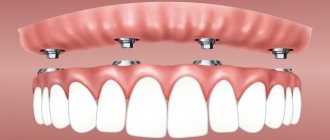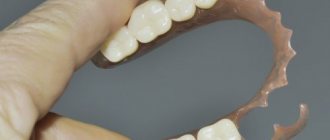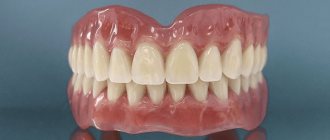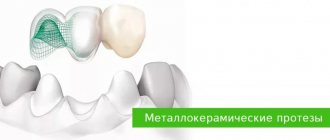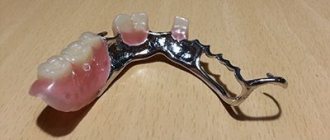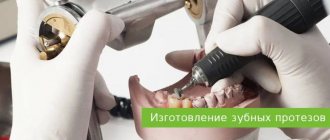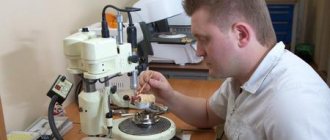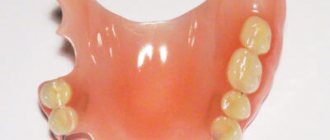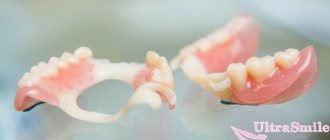Manufacturer information
The Vertex-Dental company was formed on the basis of the Dentimex company (opened in the Netherlands in 1939). The name “Vertex” itself is translated from Latin as “crown” or “highest point of something”, i.e. With just its name, the manufacturer seems to indicate that its products are of the highest quality. In the course of its development over almost 100 years of history, the company has gone from a local manufacturer of acrylic prostheses (which at that time became an excellent replacement for rubber products) to a large concern that produces plastics and production lines for most types of prostheses known today.
Today, Vertex products are supplied to 75 countries around the world and, as the manufacturer himself notes, about 100 thousand dental technicians use them daily. For about 25 years, we have had our own training department, the Vertex-Dental Academy.
A little about the manufacturer
The photo shows vertex dentures
Dental Import Export Company Dentimex is a well-known European manufacturer of materials and components for dentistry, prosthetics and orthodontics. The first plant and laboratories appeared in 1938 in Holland. They specialized in the production of simple prosthetics made of plastic and acrylic. Given the demand for the product, production capacity increased rapidly.
Vertex Denta l brand has 75 branches in many countries in Europe and America. Technological chemists have created several unique polymers that are distinguished by their quality and strength. Among the company's products:
- high quality plastics and elasticity;
- liquids for creating a polymer mass;
- materials for grinding and polishing dentures.
The brand’s denture designs are lightweight, comfortable to wear, and help patients quickly adapt to the design.
Types of Vertex materials
The most popular material from Vertex-Dental, which has been talked about lately, is the “hero” of today’s article - thermoplastic based on Vertex ThermoSens polyamide (modern nylon). Its features will be discussed further below. In the meantime, let’s touch a little on other materials from the company, such as:
- acrylic: available in two modifications - heat-curing Rapid Simplified (cadmium-free) and cold-curing Castvaria (for finishing, repair and relining),
- artificial acrylic teeth – Vertex Quint teeth: durable teeth made from 5 layers of innovative materials have a natural appearance and long service life. More than 16 shades of artificial teeth are offered for people of any age and race. Suitable for fixing on acrylic bases,
- liquid preparations for the manufacture of prosthetic structures,
- tools for manual and machine processing of products,
- devices for the full production cycle: pressing, polymerization, casting, etc.
PROSTHETICS WITH 6 OSSTEM IMPLANTS FROM RUB 220,000.
Complex implantation Osstem (South Korea) with delayed loading after 4-6 months.
Call now or request a call
Features and key advantages of Vertex Thermosens
Vertex ThermoSens thermoplastic is supplied in the form of small beads. Their color can range from transparent or white to rich pink - a total of 12 shades are produced. According to numerous positive reviews from practicing orthopedic dentists, dental technicians, as well as patients themselves, the Vertex Thermosens denture material has the following advantages:
- strength and durability: according to the manufacturer, the material is stronger than similar plastics - therefore thinner structures can be made from it. And Vertex ThermoSens “knows how” to efficiently collect excess load, reducing the risk of chips and cracks when the structure falls on the floor, for example, or when used carelessly,
- high density of the material: therefore it is minimally colored with food dyes, tobacco,
- small mass,
- high aesthetics that perfectly matches the color of the patient’s gums: the dye is not added at the end of production, but is introduced into each thermoplastic ball during mixing at the factory. Therefore, during the manufacture of the structure in the laboratory, unpleasant “surprises” are excluded, for example, poor painting, streaks or stains, unnatural shades,
- ease of polishing the material at the final stage of manufacturing,
- biocompatibility: the material contains no allergens (unless, of course, the design is supplemented with acrylic inserts), so it is suitable for allergy sufferers and people with hypersensitivity,
- minimal shrinkage over time: for Vertex ThermoSens material shrinkage is less than 1%, so the prosthesis is very precisely fixed in the oral cavity.
Features of the material
The company’s well-known development is the ultra-strong composition Vertex Thermosens. The polymer makes it possible to make durable prostheses that do not cause allergies or irritation when worn constantly. It is offered to dental laboratories in the form of small granules for further melting. They are presented in a wide range of shades, so it is easy to choose your gum color.
Thermoplastic Vertex Thermosens has a number of features:
- easy to polish and melt;
- does not shrink after the structure is manufactured;
- transparency, allowing you to give naturalness;
- Vertex dentures for teeth are easy to repair and reposition if necessary;
- 2-3 shades of color in one product .
Read Do-it-yourself dentures at home - how to make them, all stages of work on casting the structure
Prosthetics with Vertex dental structures are indicated for patients with hypersensitivity: they do not contain metal or other toxic substances.
What are the disadvantages of the material?
The disadvantages of Vertex ThermoSens are difficult to include such disadvantages of nylon as excessive flexibility or rapid darkening from food coloring. But if inaccuracies were made at the manufacturing stage of the orthopedic structure, then these shortcomings may well appear. And the prosthesis will quickly stretch or darken (and it will not be possible to bleach it). Similar defects can occur if a person likes to simultaneously eat food at different temperatures - drink ice cream with coffee, for example, or drinks a lot of red juices, wine, or smokes a lot.
Repairing such a structure is also not always possible - if there is some kind of extensive damage or a large crack, a massive build-up of material will be necessary (during relocation). And minor repairs, for example, gluing a lost tooth, building up a broken hook (clasp), can be done.
For which prostheses is Vertex ThermoSens suitable?
Dentures made from Vertex ThermoSens material are placed on any jaw – upper and lower. Designs can vary in length and method of attachment in the oral cavity. This can be a complete removable denture for the entire row with a complete absence of teeth, a partial one, as well as a “butterfly” - replaces 1-2 missing teeth. In these cases, the prosthesis is attached to the gums - due to the “suction cup” effect, and to the remaining teeth - using small hooks or telescopic crowns made of the same material. Full removable ones have a massive palate on the upper jaw, and a voluminous artificial gum on the lower jaw. Also, removable dentures on implants can be made from the Vertex material - the method is suitable for patients with complete or almost complete absence of teeth.
Interesting to know! Another type of orthopedic structures made from the Vertex material are dental splints. This product is suitable, for example, for patients with bruxism (teeth grinding).
Types of designs
Polymers from Vertex are used in the manufacture of a number of denture structures:
- splints on teeth when correcting bite;
- temporary butterfly crowns;
- bridges of various types;
- base for prosthesis on clasps or implants;
- removable jaws;
- parts for splinting gums.
Monomer-free plastic products
Resins are often used to make complete dentures that mimic the upper or lower jaw. Doctors call it flexible and comfortable, easily following the contours of the tissues in the oral cavity.
Comparison of nylon and acrylic
| Evaluation parameter | Nylon Vertex ThermoSens | Acrylic |
| Rigidity | Small but sufficient | May be excessively harsh and chafing gums |
| Flexibility | Moderately flexible | Virtually inflexible |
| Appearance | High aesthetics due to translucency | Average aesthetics, because... most materials are opaque |
| Allergy risk | Short | High due to manufacturing inaccuracies |
| Comfort of use | Medium - the prosthesis stretches greatly, like all nylon | Relatively low – for removable ones, very high – for implants |
| Risk of breakdowns | The risk of possible breakdowns of Vertex ThermoSens is low, because the material absorbs (absorbs) the load | High risk of failure due to load dissipation |
| Maintainability | Only minor defects can be repaired | Good repairability |
| Possibility of installation on implants | Only as a removable denture on 2-4 implants | For any dentures on implants – removable and fixed |
| Shrinkage of material over time | Small – less than 1% | Quite high – about 8% |
| Price | Medium and high (depending on the length of the product) | Low |
| Life time | No more than 5 years | Removable - no more than 5 years, restorations on implants - up to 10-15 years with good care |
Stages of prosthetics – manufacturing and installation
Before prosthetics, the patient must undergo treatment of teeth, gums, and stomatitis. If necessary, damaged or diseased teeth are removed. If necessary, 2-4 implants are installed per jaw. The dentist then takes impressions (molds), which are sent to a dental laboratory for the manufacture of the selected removable denture - full, partial or “butterfly”. Next, based on the cast, plaster and wax models are made - the latter is tried on in the patient’s mouth. And after adjustments, you can begin manufacturing the structure from Vertex ThermoSens. The material is processed under a pressure of 6.5 bar and a temperature of 290 degrees Celsius. At the final stage, the product is ground and polished, and then transferred to the dentist, who will install it for the patient.
Vertex dentures: advantages and features
The main feature of the Vertex prosthesis is the use of semi-rigid thermoplastic in the manufacture. It distributes pressure on the gums better and does not deform when drinking hot drinks. Among the advantages of denture construction:
- hypoallergenic;
- does not add any foreign taste to food;
- easy to care for;
- does not worsen the condition of the gums.
If you analyze the information, Vertex dentures have many reviews for and against. But the opinion of dentists is decisive. They consider plastic structures from a Dutch manufacturer to be the best in the ratio “affordable price - excellent quality.”
Read Loose teeth - treatment and prevention
How quickly does addiction take place?
The adaptation period depends on the massiveness of the removable prosthetic structure. For example, patients get used to covering products for the upper dentition in 2-4 weeks. Here the main inconvenience is caused by the covering of the palate - and you need to get used to a foreign body in the oral cavity. Partial structures cause less discomfort; according to patient reviews, they can also cause nausea or changes in taste. People quickly get used to “butterflies” and restorations on implants1, because they are reduced in size and do not cover large areas of mucous membranes in the oral cavity.
Read on the topic: how does one get used to dentures? Useful tips for patients who want to return to a comfortable life as quickly as possible.
Prosthesis service life
According to the manufacturer's research, prostheses made from Vertex ThermoSens absorb load approximately 2 times better than nylon 6, and about 7-8 times better than acrylic. It has also been experimentally established that when the hooks are bent 5000 times, they return to their original shape. Considering these data, we can conclude that the orthopedic structure will last an average of 5 years without breakdowns or repairs. But, of course, it requires adequate care.
OPERATIVE PROSTHETICS WITH ACRYLIC PROSTHETICS - from RUR 180,000.
Re-prosthetics with an acrylic bridge on a metal frame (all included) up to 12 units.
Save RUR 30,000. Call now or request a call
“After 2.5 years, I had to exchange a very good imported nylon prosthesis for an acrylic one. Because it turned out that nylon doesn’t really like hot things and changes shape. And I am a lover of hot tea. And he refused to repair my ort, he said there was no point, it wouldn’t help. But I really liked those teeth, they were beautiful and comfortable.”
Margarita, review from woman.ru
Features of caring for nylon teeth
Dentists note that although the Vertex ThermoSens material is of better quality than simple nylon, it is also not recommended for storage in a liquid environment. Therefore, if you are removing a prosthesis and do not plan to wear it for several hours or days, then place it in a dry box and not in a glass of liquid. Otherwise, caring for these orthopedic structures is no different from caring for other removable ones. Dentists suggest acting according to the following instructions:
- After each meal, the structure must be removed and washed in clean water,
- a prosthesis fixed on implants and on telescopic crowns does not need to be removed every day, but you should rinse your mouth thoroughly after meals and use an irrigator to rinse the subprosthetic space,
- do not eat very hard and sticky foods: the first type can lead to breakage, the second - to loss of fixation,
- clean the structure every day with a special brush and paste (morning and evening),
- soak the product in a disinfectant solution every week,
- Visit your orthopedist every 4-6 months to have your prosthesis examined and professionally cleaned.
Services
Modernization of technologies, the emergence of new materials and improvement of old ones are excellent grounds for the development of dental prosthetics. The last word is considered to be structures made of polymers - lightweight, flexible, durable, easily correctable and repairable. One of these newest inventions is the Vertex ThermoSens material, which is widely used in removable dentures and the manufacture of implants.
The material is sold in the form of granules of various colors, which, during the manufacture of the prosthesis, are mixed in the required proportions to obtain the required shade, closest to the color of the patient’s natural enamel and mucous membranes. It has the following advantages that distinguish it from other dental plastics:
• increased aesthetics due to translucency, which allows you to bring the light reflectance of the prosthesis as close as possible to the natural level,
• no toxicity,
• flexibility,
• strength, allowing in many cases to completely eliminate metal parts. For example, in the production of covering dentures, clasps (hooks) are made of the same material, which makes them completely indistinguishable from the gums,
• has increased moisture resistance and a dense structure, due to which the dentures do not change their color and do not absorb food odors,
• during use, the material gives minimal shrinkage (<1%), does not rub the gums and helps to avoid discomfort;
• Vertex plastic is very easy to polish,
• has hardness and does not deform even when chewing very hot food,
• impact resistance and resistance to mechanical damage,
• the ability to evenly distribute the load, preventing uneven wear of the prosthesis and damage to the supporting teeth.
The prosthesis is suitable for any age group of patients and is quickly produced by hot pressing.
What types of structures can be made from Vertex ThermoSens plastic?
Types of dental structures can be as follows:
1. A complete denture that replaces missing teeth. In this case, the role of support for prosthetics of the upper jaw is played by the hard palate, and the role of the lower jaw by the alveolar process. This type of design is completely removable, so it must be removed from the mouth every evening for safety reasons. Unfortunately, due to completely missing supporting teeth, complete dentures are unstable, and patients complain that they have to be adjusted frequently with the tongue.
2. Partially removable or covering denture is ideal in cases where there are two or three teeth or roots left in the patient’s dentition that can serve as support.
3. Conditionally removable prosthesis, supported by implants. It holds securely and does not require daily removal, but its disadvantage is that implantation significantly complicates prosthetics and makes it much more expensive.
Vertex ThermoSens material can also be used for the manufacture of various parts in the manufacture of prostheses with a metal base. Indications for the use of this polymer are allergies to other types of plastics, the unpleasant sensations they can cause in the patient and severe addiction to wearing an orthopedic device.
How to properly care for the product?
The service life of artificial teeth largely depends on proper care, which consists of the following points:
• daily brushing with toothpaste at least twice – morning and evening,
• for removable dentures – overnight storage in a disinfectant solution,
• restriction in the intake of hard and viscous foods that can deform or even break the prosthesis,
• regular visits to the dentist for preventive examinations,
• timely, qualified repairs – it is unacceptable to try to fix a broken structure yourself using improvised means.
If you follow all the rules of care, the service life of the structure will be from 7 to 15 years.
The cost of prostheses made of Vertex Thermosens plastic in our office is 22,000 rubles.
User Questions
QUESTION Hello, I wanted to know what is better to install, a Vertex prosthesis or an acrylic one? I can not decide. Anna
ANSWER Hello, Anna.
It’s quite difficult for you to answer here, because the Vertex-Dental company produces several materials for dentures - and they also have acrylic ones. If you are still interested in the difference between Vertex Thermosens (this is modern nylon) and acrylic, then you need to know that acrylic can break under stress - but it can also be repaired well. And as the manufacturer Vertex ThermoSens notes, this material will last 5 years without the need for repair. However, if you still need it, you need to understand that only minor repairs are possible here. Although more often it is necessary to make a new design. Also, Thermosens thermoplastic is very aesthetic, hypoallergenic, and flexible (which acrylic lacks). And one more disadvantage - unlike acrylic, it is not suitable for fixed dentures on implants. 1Mühlhäuser A. Removable restorations supported by implants, 2006.
Comparison of nylon with acrylic
Nylon and acrylic are the most popular materials in orthodontics. They are used to make the basis of many prostheses. But each has certain disadvantages and advantages:
- Nylon is more flexible and elastic, so it fits the gum well. Acrylic can break when bent or under strong pressure.
- Acrylic contains substances that can produce toxic compounds when exposed to hot food. Therefore, nylon is considered more hypoallergenic.
- Both materials have a porous structure, so they accumulate food particles. But acrylic requires more frequent disinfection and daily use of an antiseptic solution.
- Nylon dentures are difficult to repair or glue.
When comparing the two types of polymers, patients often prefer acrylic structures due to their low price and availability.
